
There’s a sense that we’re at a fairly important crossroads right now, environmentally-speaking. Climate change is becoming harder and harder to ignore, and even if you don’t care about being kind to Mother Nature, the steady economic pressure of fuel price volatility hits us all in the hip pocket whenever Country X decides to rattle sabres against Oil Producing Nation Y.
On the other side of the coin is the utopian vision of an emissions-free future, where cheap electricity is what gets us from A-to-B instead of liquid hydrocarbons. It’s here where the Hyundai Ioniq Electric steps in, as the first mass-market electric car from the Korean automaker and one that’s intended to normalise the electric vehicle (or EV) ownership experience. Whether you're intrigued by EVs as a means of lowering your carbon footprint or merely lowering your vehicle running costs, the Ioniq Electric should pique your interest.

We’ve experienced the Ioniq in small doses so far, but now we’re parking it in our long-term garage to see how it fares during driving that’s a lot closer to what the Average Joe and Josephine would subject it to. Besides the usual do-the-plastics-start-creaking part of long-termer assessment, we want to cast a critical eye over things like the Ioniq’s comparatively limited (230km claimed) range, its charging times and whether the act of having to frequently plug it in starts to do our head in after a few weeks.
Retailing at $48,990, our Ioniq Electric Premium caps off the six-model Ioniq family, which covers regular petrol-electric hybrid variants and a pair of plug-in hybrids, in addition to the two all-electric offerings – the $44,990 Ioniq Electric Elite, and the Ioniq Electric Premium we’ve got on long-term loan. Costly for a non-luxury small car, but that's the price of early adoption.
We’ll be sharing it across the WhichCar team over the next six months, which should be plenty of time to see whether the utopian ideal of all-electric motoring really is compatible with a modern Australian lifestyle. Keep checking back here to see how it’s travelling!
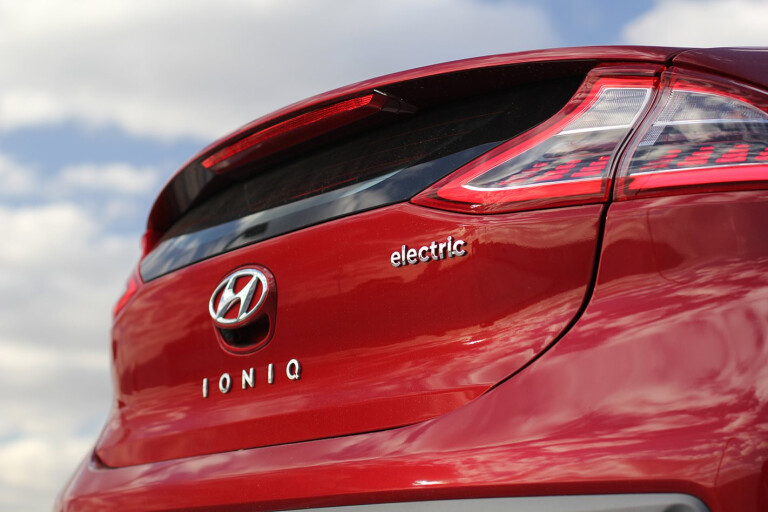
UPDATE 1 - 7 April 2019
So far, so good. The Ioniq has been kept busy shuttling me from home to office, and its been a great tool for what is otherwise the most boring thing you can do behind the wheel: commuting.
In fact, anyone who has to face the drudgery of driving to work and back for five days out of every seven really should be doing so in something electric. The seamless torque of an electric motor, the near-silence of its powertrain and, when you dial up the regenerative braking to full strength, the bulk of the drive can be done by simply modulating the accelerator pedal - you only ever need to prod the brakes when coming to a complete halt.
And besides, why are we burning precious hydrocarbons just to propel ourselves to our jobs? Petrol's a finite resource, and I'd rather save it for driving that's actually fun. In that regard, I'm all on board with the electric revolution. If only it were a little more affordable - near $50K for a non-premium small hatch is a touch steep, methinks, and sadly restricts the likes of the Ioniq Premium to early-adopter types.

At 230km of claimed range I'm currently able to go to and from work for at least three days without recharging - including the occasional after-hours short journey to the shops - so range anxiety hasn't really reared its ugly head just yet. That said, I'm not exactly in the habit of running the battery down into low figures. It's probably also worth mentioning that the car's computer doesn't reckon I'm an efficient enough driver to unlock the full 230km range either, instead telling me that with my current driving style I'll only get around 210-215km from a completely topped-up battery. Let's see if I can convince it otherwise.
I've got some road trips coming up that should test the Ioniq's range claim, but for now just one other feature warrants a mention for this update: the Ioniq Electric's open-plan centre console. Combustion-engined Ioniqs get a conventional set of console plastics, but the EV deletes all that for a space-liberating floor-mounted tray between the footwells, which I can happily confirm is large enough to tote an entire roasted rotisserie chicken (my metric of choice for measuring in-cabin storage), and then some. Handy!
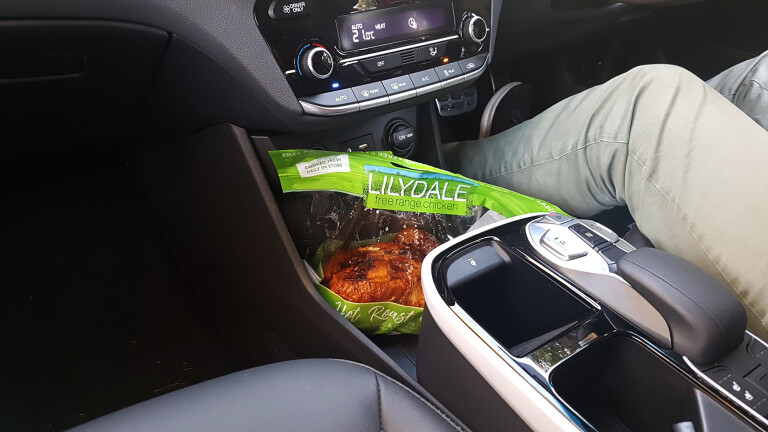
Update 2 – 19 April, 2019
This update will be a quick one, given the poor Ioniq has been neglected of late thanks to a large flow of other cars in the WhichCar carpark. In fact, the only real trip of note I’ve taken in it was to the airport long-term carpark, where it then spent five days parked up while I went overseas for the launch of the updated Jaguar XE and F-Pace SVR.
Unless you have a Tesla, there are no EV charging options at Melbourne Airport’s car parks, either short term or long term. Even if you do own a Tesla, to juice it up while you’re out of town you’ll need to park it at Qantas Valet Parking – the costliest option at an airport that’s already exxy to park at.
But with a full charge and a home-to-airport distance of roughly 40km, the lack of charging infrastructure wasn’t a problem on my visit. The Ioniq’s battery is more than big enough to get me there and back. However, the length of time it would spend sitting idle did get me thinking – would a hydrogen car be problematic on a such a trip?
For those that don’t know, hydrogen cars have a bit of an engineering issue to overcome: the tanks leak. Not by a dangerous, explosion-starting amount, mind you, but with hydrogen molecules able to literally slip between the molecules of most other materials, it’s a difficult gas to contain. The actual rate of hydrogen leakage varies, of course, but as an example Ford was targeting 0.05 grams of hydrogen per hour as an ‘acceptable’ rate of tank permeation.
Which would mean that over five days you’d lose… just six grams of hydrogen to the atmosphere. Six grams in a car that would likely carry around five or six kilograms of hydrogen on board. It’s a negligible amount, so I guess my fear is unfounded.
But here’s the thing: while hydrogen cars are still very much in their infancy with many technological and infrastructural hurdles ahead of them, electric cars have already arrived. Why wait for hydrogen when the future is already here?
Update 3 - 27 April, 2019
The first fault has appeared - the passenger seat belt warning has taken it upon itself to start bonging away even when the front left seat is vacant, which you can no doubt imagine took me a little while to figure out what the source of that noise was. No, it's not because a heavier-than-normal bag has been placed upon the cushion either, the sensor in the seat cushion that detects a passenger's weight must have somehow become permanently closed.
The remedy for this (at least until I can take it back to Hyundai) is to drive around with the front passenger seatbelt buckled in at all times which, aside from looking a bit weird, also makes me feel like I'm some kind of Uber driver for ghosts. Other than that, though, the Ioniq Electric has been pleasingly trouble-free.
Recent political chatter around EVs has got me wondering though - just how much is this car costing me to run? It's hard to tell. At least with a petrol car the costs are quite visible, because they're literally right in front of you on the bowser every time you fill up. It's a lot less transparent with an EV though, as those costs are built into your electricity bill. I have a plan though. Stay tuned.
Update 4 - 7 May, 2019
Alright, so I promised I’d get a little more scientific with the numbers and measure precisely how much energy the Ioniq was actually consuming. The running costs of EVs are already well-known to be cheaper than combustion-powered equivalents, but armed with such data I can properly quantify for you, dear reader, precisely how cheap it is to run an electric car.
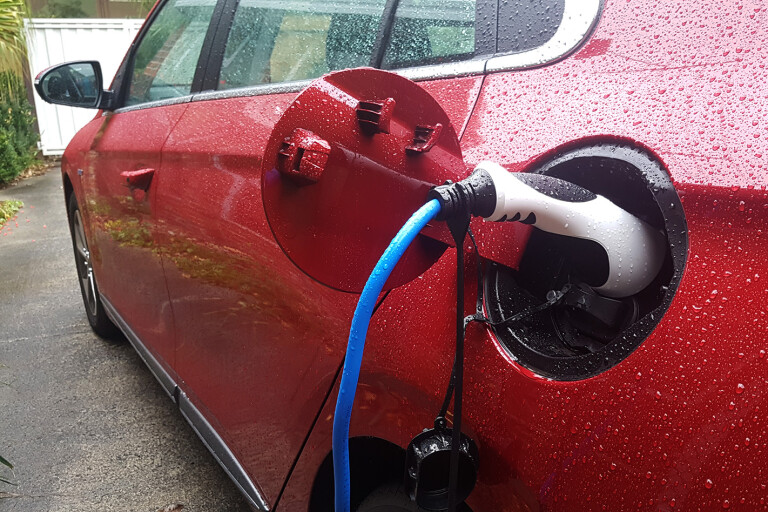
To do so I acquired an energy meter that counts the kilowatt-hours flowing from a single power point. It sits between the household power outlet in my garage and the Hyundai’s regular charge cable, so every electron that passes through it is energy that’s going into the car’s battery – long story short, this is as precise as it gets.
I started last week with a full battery and only recharged three times, the third being a very minor top-up on Sunday evening to bring the battery back up to 100 percent and thus give me the total energy consumption for the week’s motoring. The result? The Ioniq went through 32.9kWh of electricity in a seven-day period with 203.2km of distance travelled in mostly peak-hour urban driving. About 25 percent of the total was covered on the highway at 100km/h.
Yes, that kind of power consumption will make your electricity bill positively explode, but here’s the thing – you’ll be saving so much money on fuel that you won’t care.

At 33 cents per kilowatt hour, my household power plan isn’t the most competitive deal around. Even so, the cost of the past week’s driving comes in at $11.07 total, or $5.45 per 100km travelled. That’s… still actually pretty good.
With some energy plans promising far more reasonable peak-time rates of 20-25 cents per kilowatt hour, the cost would shrink even further to between $3.29 and $4.11 per 100km. Charging just with off-peak energy? At the going rate of 17 cents per kilowatt hour, the Ioniq would cost a paltry $2.79 for a hundred kilometres of motoring. Substantially less than a cup of coffee.
Now consider that a petrol-powered i30 2.0-litre manual would need $10.22 per 100km at today’s fuel prices, and that throws EV running costs into sharp relief. I’m a firm believer that it’s not the idea of being kind to the environment that’ll drive EV uptake in this country, but dirt-cheap running costs. These numbers back up my hunch - the savings are just supremely generous.

Even line it up against Toyota’s hybrid hero, the Prius i-Tech (which is the only petrol-drinking small car to come within a few thousand of the Ioniq’s pricetag), and the Toyota is harder on the hip pocket. If you can get a Prius to achieve its factory claim of 3.4L/100km, it’ll still cost around $4.75 per 100km. However making a Prius pull that kind of economy number is notoriously difficult, whereas our week-long drive in the Ioniq was done with reckless abandon for efficiency. Full-power traffic light launches? Why not?
So there you have it. The gulf between EV and petrol running costs are massive, but the major barrier of ‘purchase cost’ has yet to fall. Once it does, I have no doubt that Australian drivers will start to wake up to the incredible value of EV motoring and start looking at mainstream EVs like the Ioniq and Nissan Leaf in a more serious way.
What flow-on effect that’ll have for our power infrastructure, however, remains to be seen.
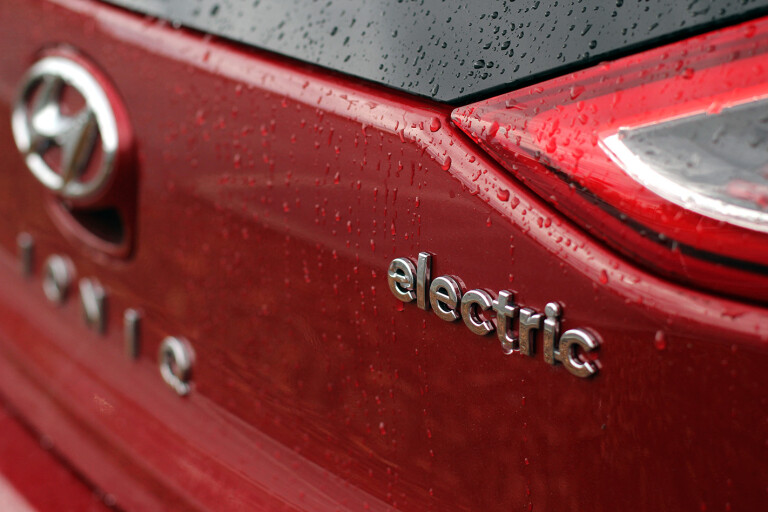
Update 5 - 24 May, 2019
Has it really been nearly three weeks since the last update? Time has flown, but the Ioniq has continued to serve well as a weekday hack, and the longer I drive it the more relaxed I feel both on the way into work, and when I arrive home. There's some intangible quality about driving a car this smooth and quiet that has a calming effect, which is great.
Or maybe it's just smugness I'm experiencing? Hang around on the internet long enough and you'll quickly figure out that most Tesla owners seem to believe they're single-handedly saving the planet, so maybe the Hyundai's giving me a smaller dose of the same sickness?
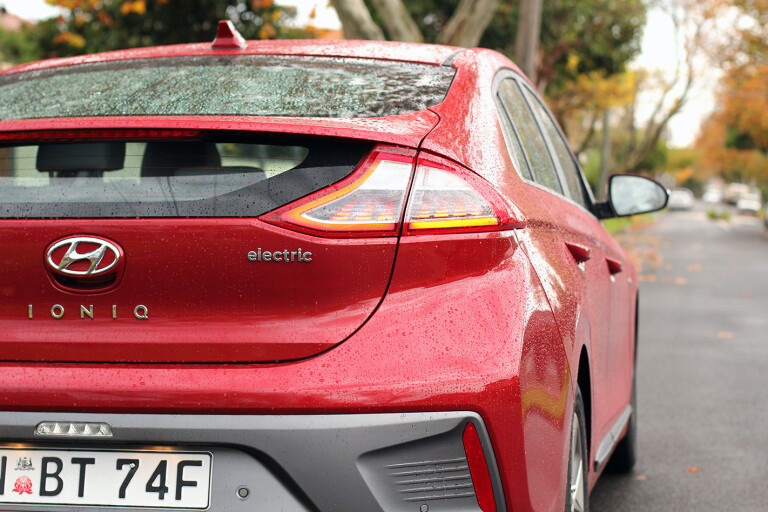
Either way, just like a Tesla there's no hiding the fact that this an electric car from passers-by. Besides the chrome 'ELECTRIC' badge on the back of the hatch, the faired-over front bumper announces to everyone that yes, this car does things differently.
It's the only explanation for why some random lady pointed to the front of the car as I drove past and gave me an enthusiastic thumbs-up. Maybe she knew what it was or perhaps thought it was a far more fashionable Tesla Model 3, but it's clear that grille-less bumpers are very much an EV trait.
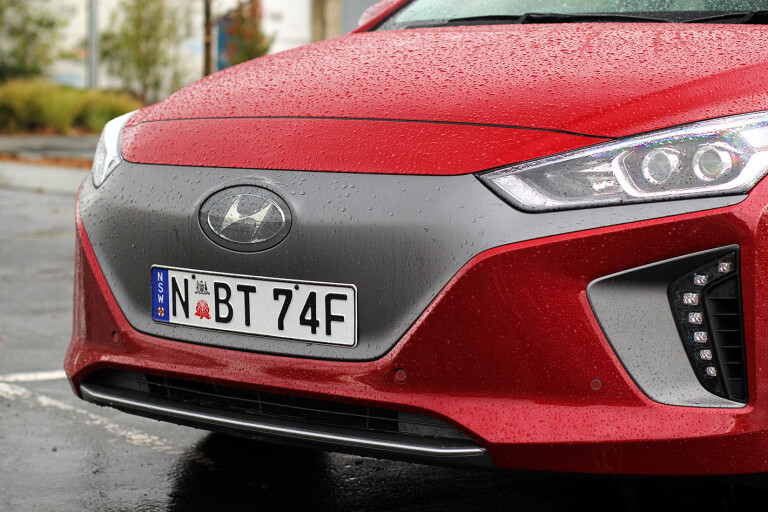
Virtue signalling, much? Personally, I'd rather fly under the radar and leave the overt displays of eco-mindedness to the Tesla crowd, whose eagerness to virtue-signal borders on vegan-esque. Yes, I know the Ioniq Electric's front bumper looks that way because there's bugger-all need for cooling, but maybe a subtler treatment would give it a more 'mainstream' appearance. Like the bulk of the population, I'd rather not draw too much attention to myself.
But that's just me.
Other things to report? Happily the passenger seatbelt sensor has fixed itself and no longer bongs when the seat is vacant, but now I've got a new problem. Melbourne is very much in winter mode, and the morning chill is doing bad things to the Ioniq's power consumption. Via the on-board data, the car's heater is consuming around 3kWh on average, and sometimes up to 6kWh if the differential between the ambient and set temp is dramatic. I'll go into the numbers on the next update.
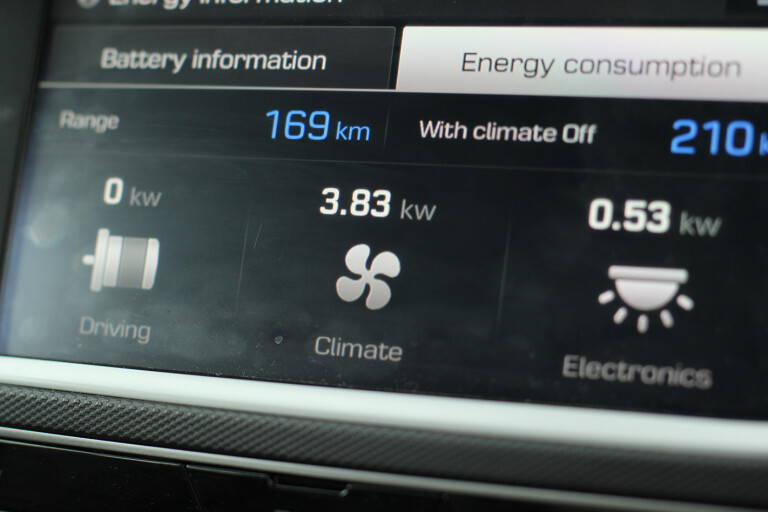
Update 6 - 2 June, 2019
I think I've come across what is perhaps the electric car's greatest bugbear, and it's not a dearth of charging infrastructure. Rather, it is this: in cold weather you're going to have significantly less range to work with than in winter, and it's all the heater's fault.
Melbourne in winter is melancholy at the best of times, what with brutally cold mornings and frequent rain doing their best to dampen your spirits. For many commuters, the ability to blast the heater all the way to work is a welcome respite, but doing so in the Ioniq just gives you something else to worry about - diminished range. If the climate control has to heat up a 10-degree cabin up to a more liveable 22 degrees, the car's heater can draw 6kW - or more - to do so. For reference, when cruising at 60km/h on level ground the Ioniq EV's drive motor burns about 12-13kW, so the heater's consumption could be up to half of the energy that's needed to move the vehicle itself. Once the set temp is reached the energy consumption tapers off, but it's rarely less than 1kW.
Staying warm is an incredibly energy-intensive activity, but it's not something a regular combustion-engined car has to worry about. Most petrol and diesel vehicles run their heaters off the engine's coolant, so the cabin is warmed up from what is essentially waste heat. In fact, in those cars you're actually making your car more efficient when you flick the heater on. The opposite is true of an EV.
What's that mean in terms of single-charge range? Bank on anywhere between 40-70km being wiped off your theoretical maximum, which is a fair hit in a car that only has a full-charge range of 230-240km to begin with.
However, there is a way around this... kinda. The Ioniq EV Premium comes with heated front seats and a heated steering wheel as standard, and turning all of them to full doesn't use anywhere near as much energy as the heater does - you could conceivably turn off the climate control heater and rely entirely on the seat and steering wheel for warmth. Their effect is also more instantaneous as the heat is being applied directly to your hands, thighs, back and bum. That said, it still feels a bit miserable having to keep a coat, scarf and hat on to fend off the still-frigid cabin air, while just a few select parts of your body get gently toasted. Sadly when it comes to maximising your range and staying warm in winter, the Ioniq forces you to choose only one of those things.
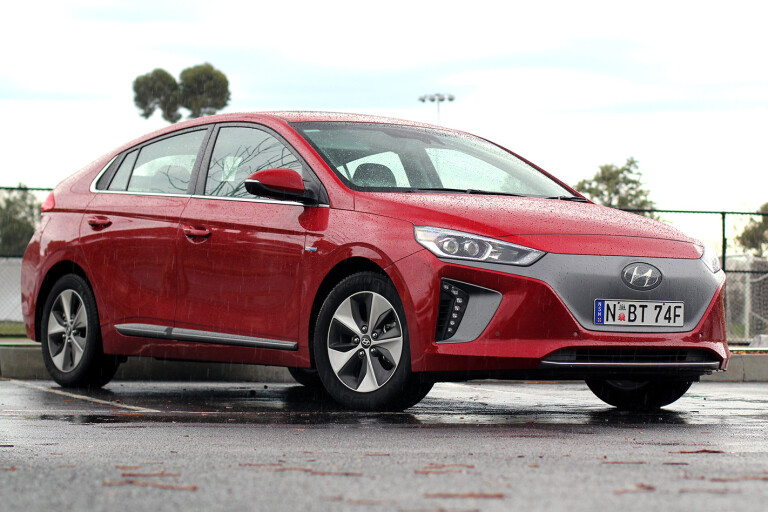
Update 7 - A better way?
“Is there a better way of doing this?”
That’s the thought that’s occupying my mind lately, when pondering the whole EV conundrum. Don’t get me wrong, I think the idea of electric cars is fantastic. As a car for urban commuting they’re perfect, but first-hand experience of living with one is starting to seed some doubt in my mind as to whether to challenges of integrating them into Aussie life will be worth the trouble.
And that’s no fault of the car itself, mind you. I’m still really enjoying driving the Ioniq EV, and in my mind it’s still the best version of the Ioniq by far. Rather, batteries are the issue.
It’s becoming increasingly obvious that batteries are the bottleneck that’s slowing us down on the path to a properly renewable society. Even the current state-of-the-art lithium-ion batteries are bulky and heavy, which introduces difficulties when integrating them into a car, but they’re also expensive and made of materials that are either hard to find or environmentally destructive to manufacture.
Furthermore, if Australians are indeed going to embrace EVs in a big way, that’s going to savage our power distribution infrastructure. The extra load of charging hundreds of thousands of electric cars would surely tax powerlines that aren’t accustomed to that kind of demand, unless everyone is conscientious enough to wait until off-peak hours to activate their chargers.
But imagine this: instead of a heavy battery, your car had a tank of hydrogen as its energy source. Imagine also that you were able to refill that tank using a solar-powered hydrogen generator that’s located right within your house or garage, just like a water heater. While you’re out of the house that generator is charging up its own tanks, and when you get home all you need to do is plug your car into the generator and wait a few minutes for the gas to transfer, rather than waiting eight or ten hours for a battery to charge up.
What’s more, your house could run on that same gas, potentially liberating you entirely from the power grid. This stuff isn’t science fiction, by the way, as household-size hydrogen generators and stationary fuel cells are already commercially available.
This is the utopian vision of the hydrogen economy, and besides giving you a car that’s lighter (and thus requires less energy in total to propel itself) and which can be ‘recharged’ much faster than an electric car with comparable range, it results in a decentralised energy infrastructure that is truly zero-emissions. The need to mine huge quantities of rare minerals for the world’s automotive batteries would cease to be a problem, as hydrogen is infinitely renewable.
Don’t have a garage or driveway to permit the refuelling of your car, can’t afford to buy a hydrogen generator, or you’re out on a long road trip? That’s fine, because the hydrogen vision sees existing petrol stations simply switching over to dispensing hydrogen rather than hydrocarbons – your current refuelling habit wouldn’t need to change. You also wouldn’t need to hang out for half an hour at an EV fast-charger, either.
But like so many utopian ideals, the hydrogen economy still has some kinks to be worked out. Generating hydrogen needs lots of energy, and it’s a much less efficient process than transferring power from a solar panel directly into a vehicle’s battery. When it comes to transitioning from combustion engines to something properly eco-friendly, there’s no silver-bullet solution.
And what’s more, hydrogen cars and the infrastructure needed to support them simply aren’t ready for prime time just yet, whereas electric cars are well and truly here. The fact that production battery-electric cars like the Ioniq EV have arrived on the scene first is a strong indication that they’ll be the dominant force in the future, at least for a good couple of decades.
So while there definitely seems to be “an even better way”, it still seems to be more than a little bit distant. For now, though, the minor inconvenience of plugging in the Ioniq EV every few days is still infinitely preferable to burning fuel on the weekday commute.
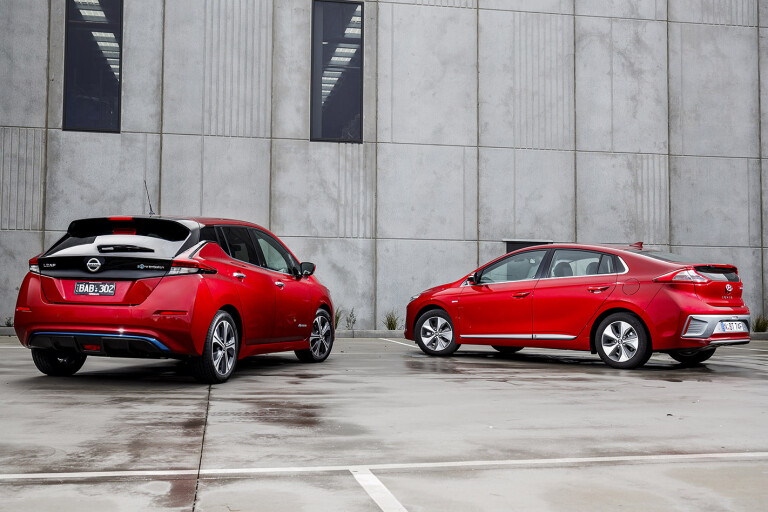
Update 8 – Meeting the competition
It’s taken a while, but now there are two EV hatchbacks at similar price points vying for your dollar on the Australian market. The Ioniq is very much no longer the only feasible option.
The new Nissan Leaf is now here, and at $49K it lobs for just a thousand dollars more than the Ioniq Electric Premium. We’ve put the Leaf and Ioniq head-to-head for an upcoming issue of Wheels magazine, and while you can't read the outcome of that test just yet, I will say this: the two cars really do differ quite significantly.
For one, the Leaf has a bigger battery. With 40kWh of capacity the Leaf has a substantial 12kWh more energy storage than the Ioniq Electric, and its real-world range claim of 270km is a substantial 40km over what the Ioniq will do.

That alone suggests the Leaf wins the value equation. Batteries are far and away the most expensive part of any EV, and for Nissan to offer a battery that’s 42 percent bigger for just $1000 more seems like a pretty good deal.
But there are other technological reasons to choose the Nissan. Its climate control heat pump is one, given it takes waste heat from the battery and uses it to help the cabin warm up in cold weather, rather than just burning heaps of electrons in an electric heater. The Ioniq’s range is decimated by running the climate control in winter, but the Leaf only cops a modest hit thanks to that heat exchanger. A nerdy detail, but it really does make a difference for an electric car.
And then there’s the car-to-grid capability of the Nissan Leaf. Sure, we still need to wait for an energy provider to sign on to support that particular tech, but the idea that your car could earn you money while it’s parked and plugged in is a very enticing concept. Again, that’s a feature the Ioniq simply doesn’t have.
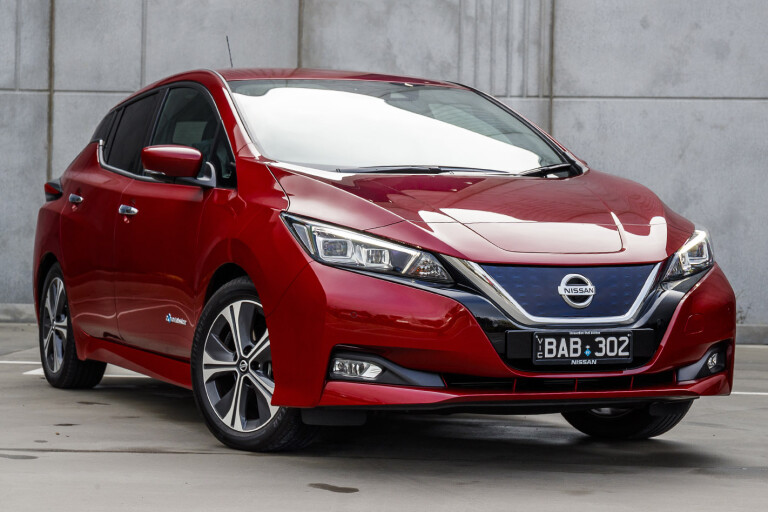
On the other hand, the Leaf is hobbled by its weird packaging, high driver’s seat position, lack of reach adjust for the steering wheel, poor rear seat comfort and wobbly handling. The Ioniq is clearly superior in these areas.
But as an electric car, the Leaf just seems like a better demonstration of the potential of EVs versus combustion cars. I’ll be honest, I’ve thoroughly enjoyed my time with the Ioniq thus far, but experiencing the second-gen Leaf has taken some of the sheen off Hyundai’s electric hatch.
Want to know which one comes out on top? You’ll have to read all about it in the October issue of Wheels magazine.
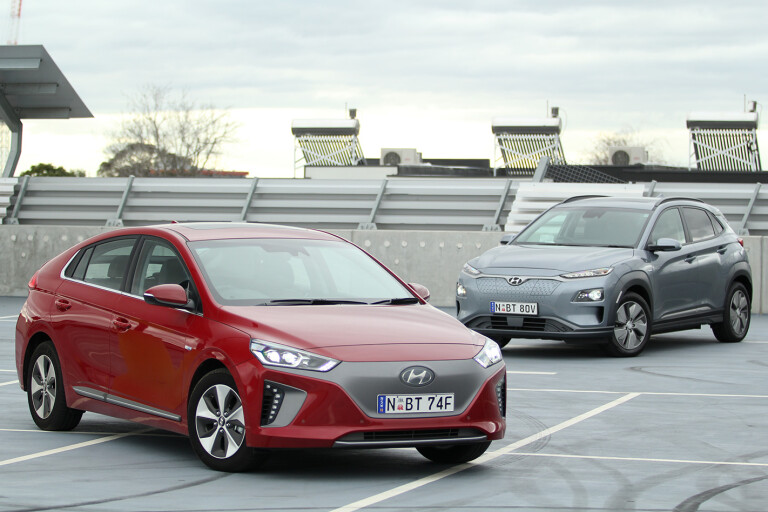
Update 9 – Family Resemblance
It now comes time for us to say goodbye to our electric Ioniq. It’s served us well, and it’s answered some important questions about what life is like with an electric car. Is it difficult? Not really. Does it require a change in behaviour and attitude? Absolutely.
If you’re thinking that owning an electric car can – or should – be anything like operating a combustion-engined vehicle, then they’re not for you. Range is a limiting factor and so is the recharging time (which even for the modest battery size of the Ioniq, requires the better part of a day to charge up from near-zero), but treat it like your mobile phone and those problems diminish greatly.
Popping it on the charger every second or third night is all most people will need to do to ensure they’re never left stranded, but longer journeys out of city centres definitely require more planning. The Ioniq isn’t really the car for that kind of driving, but with the average Aussie family’s garage already having two cars in it then making one of them electric for day-to-day duty makes a whole lot of sense.
However what if you don’t want two cars, but you definitely DO want an electric? Hyundai might still have you covered.
 The second EV to join its showrooms arrived in Australia earlier this year – the Hyundai Kona Electric. It ain’t cheap at $59,990 for the cheapest version (add $5000 for the high-spec Kona Electric Highlander), but it does boast a single-charge range of 449km in real-world driving conditions.
The second EV to join its showrooms arrived in Australia earlier this year – the Hyundai Kona Electric. It ain’t cheap at $59,990 for the cheapest version (add $5000 for the high-spec Kona Electric Highlander), but it does boast a single-charge range of 449km in real-world driving conditions.
Now that’s a number that compares pretty well with something petrol-powered.
It certainly trounces the Ioniq on range, virtually doubling the distance our long-termer can travel on a full battery. What of the rest of it though? Lining the two up against each other, the Kona has a tighter boot area and a less spacious rear seat, though it looks more futuristic from the outside and it’s hard to deny the greater appeal of its SUV styling and taller seating position.
 We’d still lean toward the Ioniq, however, primarily because its $49K price tag is less egregious. Neither are good value, but the Ioniq will take less time to justify its worth through fuel savings.
We’d still lean toward the Ioniq, however, primarily because its $49K price tag is less egregious. Neither are good value, but the Ioniq will take less time to justify its worth through fuel savings.
We’ll miss the Ioniq. Having a combustion-less option in the garage made light work of zipping up to the shops or dashing into the city, and the running costs were astoundingly cheap. If you’re able to charge it on solar power, it’s virtually free.
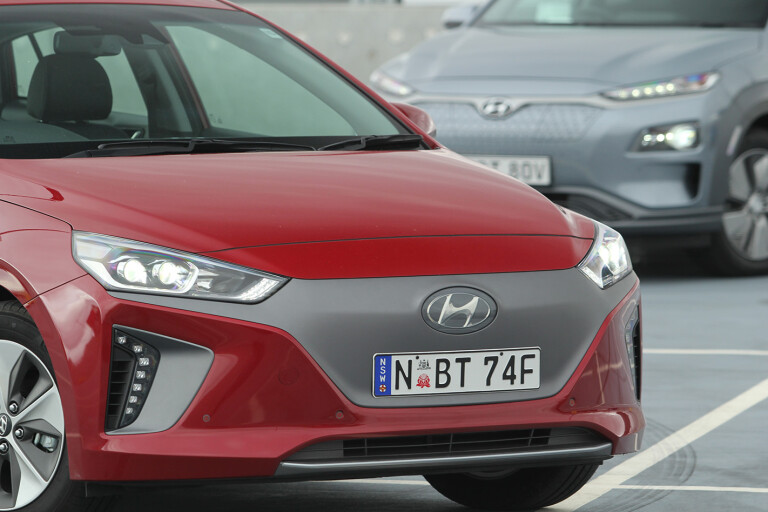
Is it ideal for everyone then? Of course not. Those who regularly drive long distances will be let down, as will anyone who doesn’t have the luxury of a garage, driveway or carport that allows them to charge it up.
Best of luck if your home is an apartment, or only has on-street parking.
However for Australians looking for a likeable, versatile and cheap to run city runabout, the Ioniq Electric is just about perfect.
COMMENTS